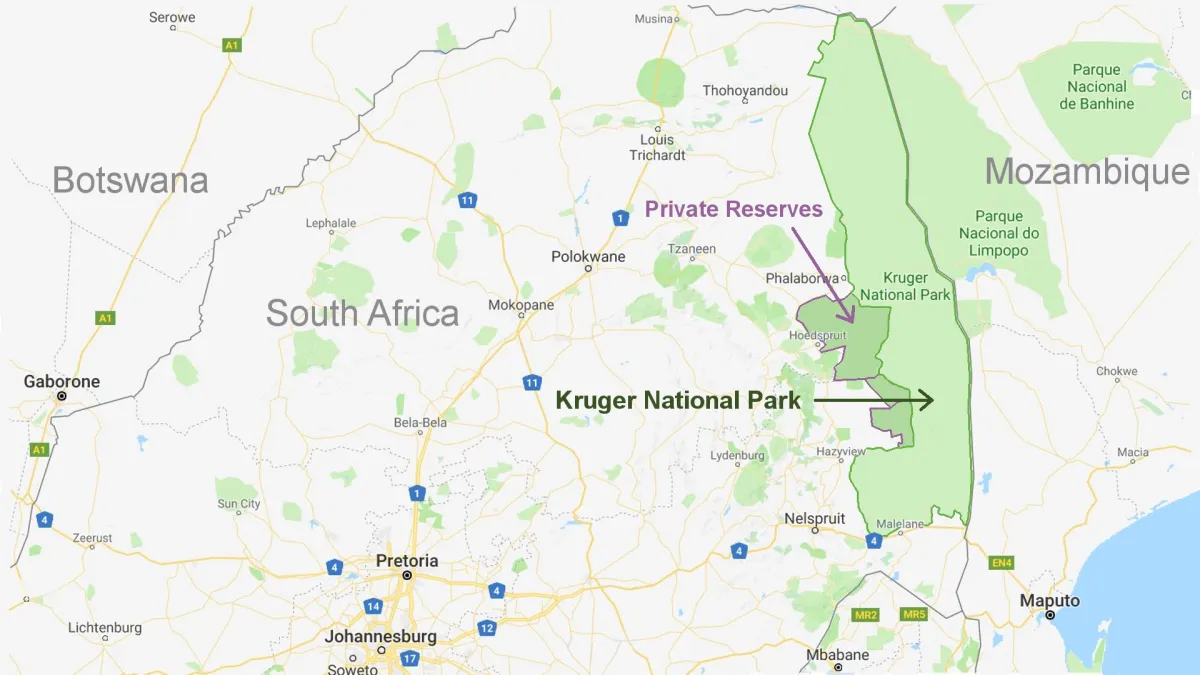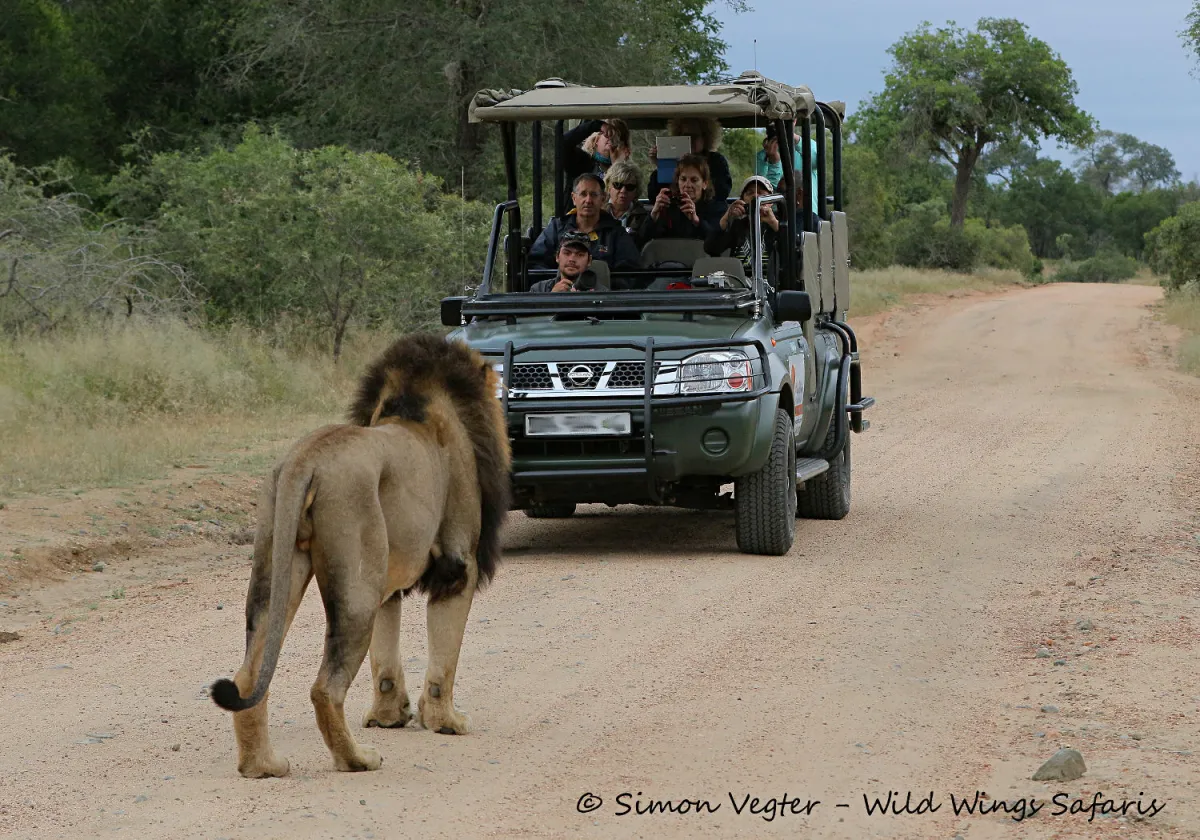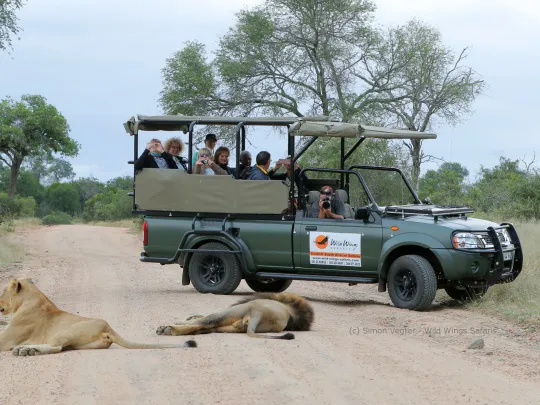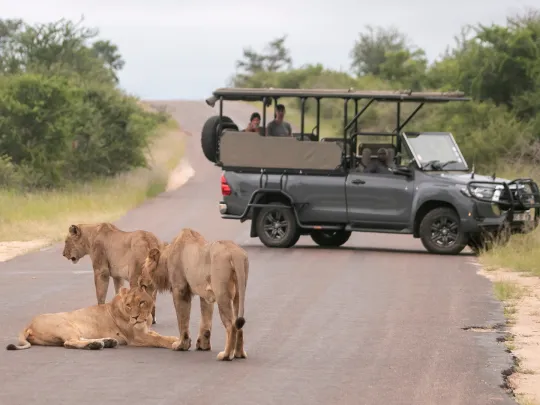Kruger National Park vs Private Game Reserves – Which Safari is Best?
One of the most common questions we get from travellers is: What's the difference between Kruger National Park and the private reserves next to Kruger?
Both options offer incredible wildlife encounters, but they differ in terms of accessibility, accommodation, game viewing, and overall experience. Some safari-goers prefer Kruger for its vast landscapes and diverse wildlife, while others favour the exclusivity and luxury of the private reserves.
Let's break down the differences to help you decide which safari suits you best.
Kruger National Park

Greater Kruger conservation area
Kruger National Park is one of Africa's largest and most famous wildlife parks, covering over 2 million hectares—roughly the size of Israel. It forms part of the Greater Kruger conservation area, which also includes the private game reserves with unfenced boundaries, allowing free movement of animals
Did You Know?
Kruger National Park was officially established in 1926, but its origins date back to 1898, when President Paul Kruger of the South African Republic first declared the Sabi Game Reserve a protected area. This laid the foundation for what would become one of Africa's largest and most famous wildlife conservation areas.
Kruger National Park is part of the Great Limpopo Transfrontier Park, a massive cross-border conservation area that connects Kruger National Park (South Africa), Limpopo National Park (Mozambique), and Gonarezhou National Park (Zimbabwe). With unfenced boundaries, this protected region allows wildlife to roam freely across over 35,000 square kilometres (13,500 square miles), creating one of the largest and most ecologically significant wildlife corridors in the world.
What to Expect on a Kruger Safari

Kruger also allows close up predator sightings
- Larger traversing area: You'll cover greater distances, see more varied landscapes, and encounter larger herds of animals.
- More self-drive and budget-friendly options: Kruger is accessible for self-drive safaris, and accommodation inside the park is more affordable than in private reserves.
- Better overall wildlife numbers: Because of the park's size, you're more likely to see a greater variety of species in Kruger than in a private reserve.
- Expert-guided safaris without trackers: Unlike private reserves, Kruger safaris are led by a single experienced guide who also drives the vehicle. Guides stay in touch with one another, sharing real-time updates on sightings—so you won't be aimlessly driving around, hoping to get lucky like you might on a self-drive safari.
- Open safari vehicles with protection from the elements: Game drive vehicles in Kruger have a canopy and canvas sides, providing some shelter from sun, wind, and light rain while ensuring excellent visibility.
For the best experience, we recommend spending at least three days and two nights on a guided Kruger safari. This gives you enough time to explore different regions and maximise your chances of seeing a variety of wildlife. A professional safari guide makes all the difference—you'd be surprised how easy it is to overlook well-camouflaged animals. That shadow in the bush? It's not just a shadow—it's a leopard searching for the perfect tree to stash its kill.
Kruger Safari Considerations
- No off-road driving: All game viewing is restricted to established roads, so you won't be able to follow animals into the bush for a closer look.
- Self-drive congestion: Popular sightings, especially of big cats or rare species, can attract multiple vehicles, leading to traffic congestion in certain areas.
- Fixed game drive hours: Game drives are limited to sunrise-to-sunset, except for night drives offered by SANParks. However, we have no control over the quality of SANParks' night drives. Guest feedback has been mixed—some travellers were delighted, while others found the experience disappointing, as not all SANParks rangers are as dedicated or enthusiastic as our expert safari guides.
- Guided bush walks available: You can book a guided bush walk led by two armed SANParks rangers. These walks accommodate a maximum of 8 participants, offering a more immersive wilderness experience. However, children are not permitted, and a typical morning walk lasts about 4 hours.
More About Kruger's Roads
Kruger's road network includes well-maintained tarred roads for easy access, while secondary routes consist of good-quality gravel roads with significantly less traffic, offering a quieter safari experience.
Spanning approximately 19,485 square kilometres, Kruger is comparable in size to Israel or Wales. It features about 850 km of tarred roads, which help manage visitor access while minimising environmental impact. Restricting vehicles to designated roads prevents habitat destruction, ensuring a balance between wildlife conservation and tourism.
Kruger Accommodation Options
- Over 20 different SANParks-managed camps
- Choices range from budget-friendly campsites to basic chalets and luxury guesthouses
- Most accommodations are simple but comfortable, with en-suite bathrooms, air-conditioning, and daily cleaning
Accommodation on Our Kruger Park Safaris
Stay in a standard air-conditioned bungalow featuring mosquito screens and a small en-suite bathroom. These bungalows are clean, comfortable, and serviced daily, offering a cosy retreat after an exciting day on safari. Most units include two or three single beds per room.
For those looking for an upgraded experience, we can arrange luxury bungalows or even 4-star hotel accommodation at an additional cost, subject to availability. Let us know your preference, and we'll make it happen!
We overnight in main rest camps located in the southern region of Kruger National Park, providing prime access to some of the park's best game-viewing areas. The exact camp is subject to availability, but all are safely enclosed with electric fencing. Each camp offers convenient facilities such as a swimming pool, restaurant, curio shop, and a viewing deck overlooking the river—the perfect spot to unwind and soak in the beauty of the wilderness.
Private Game Reserves

Off-road game viewing in Timbavati Private Nature Reserve
What to Expect on a Private Reserve Safari
- Off-road game viewing: Vehicles can drive off-road to follow wildlife, allowing for closer and more immersive sightings.
- Fewer vehicles at sightings: Unlike Kruger, where sightings can get crowded, private reserves limit 2–3 vehicles per sighting for a more exclusive experience.
- Expert guides & trackers: Many private reserves employ skilled trackers from the local community who sit on a small seat at the front of the vehicle. Their job is to look for fresh animal tracks, spot wildlife, and assist the guide, who handles all the driving and explanations.
- Night game drives included: Most private reserves allow night drives using spotlights to track nocturnal predators in action.
- Open safari vehicles: Most safari vehicles in private reserves are completely open, with no sides or canopies. Some lodges, especially in summer, use canopies for shade.
- Guided bush walks: Many lodges offer guided bush walks after breakfast, while some provide longer walking safaris instead of game drives. At select lodges, guides may even stop the vehicle, assess fresh tracks, and take guests on a short impromptu walk to follow an animal on foot—depending on the species and guest preferences.
More About Private Reserves
A small number of private lodges do not allow off-road driving due to landowner policies. If this is important to you, we'll take it into account when recommending lodges.
The quality of guides can differ significantly from lodge to lodge. Even within the same camp, some guides are highly experienced, while others are still learning. We regularly visit the lodges we recommend, paying close attention to the quality of guiding and gathering guest feedback.
Private Safari Considerations
- Smaller traversing areas: Unlike Kruger's vast landscapes, lodges operate within private reserves (ranging from 2,000–10,000+ hectares), meaning you'll see less variety in terrain.
- Less predictable wildlife numbers: Game viewing varies depending on the reserve's location, season, and daily wildlife movement.
- Higher cost: Private lodges are typically more expensive, with prices ranging from $300 to $1,800+ per person per night.
- Thicker bush, not open grasslands: Most private reserves bordering Kruger are dominated by savanna woodland, thorny bushveld, and mopane woodland rather than vast open grasslands. While some smaller open areas exist, don't expect endless plains. For the best open grassland areas in Kruger, look around Satara Camp in central Kruger.
Points Worth Mentioning
Self-drive vehicles are not allowed in private reserves, and sightings are managed by limiting the number of vehicles present. Some reserves allow only two vehicles per sighting, while others allow up to three. If a sighting is busy, you may have to wait your turn and could be limited to 10–20 minutes before moving on.
Vehicles in private reserves stay in radio contact, sharing sightings with each other. While the sound of the radio can sometimes be distracting, this system helps guides locate special sightings, enhancing the overall game-viewing experience. Some open safari vehicles in Kruger also use radios to share sightings—though this practice is controversial, as calling in sightings over the radio is not officially permitted in the national park.
Private Lodge Accommodation
- More luxurious than Kruger's public rest camps: Expect high-end accommodations with premium amenities.
- All-inclusive packages: Rates typically cover meals, game drives, and sometimes drinks. However, transport to the lodge, as well as conservation or reserve entrance fees are usually additional costs.
- Varied levels of luxury: Options range from mid-range tented camps to ultra-luxurious safari lodges with private pools and butler service.
- Fixed daily schedule: Private lodges follow a structured itinerary, with set meal times and two game drives per day (morning and afternoon/evening). A typical one-night stay includes lunch on arrival, an afternoon game drive that extends after sunset, dinner at camp, and an early morning game drive the next day, followed by a late breakfast. Check-out is around 10 am, but if you're staying multiple nights, some lodges offer a short bush walk after breakfast.
The Right Private Lodge for Your Safari
Game viewing at private lodges depends on multiple factors, including the reserve, season, lodge location, animal movement, and the skills of the guide and tracker. However, some reserves have known trends. For example, leopards are frequently spotted on game drives in the Sabi Sand, while in Balule, they are much more elusive and may only be seen once a week. If you're keen to see white lions or wild dogs, let us know—we can recommend the best reserves to maximise your chances.
While private reserves generally offer more luxurious and expensive accommodation than Kruger's public rest camps, there are a few exceptions. A handful of basic yet affordable camps provide a more budget-friendly way to experience a private game reserve without compromising on the exclusive game-viewing experience. If you're looking for a cost-effective private safari, we can help you find the best options.
No two safaris are exactly alike, but most follow a rhythm that balances adventure with relaxation. From exhilarating early morning game drives to sundowners by the fire, each day offers something special. Find out what to expect by reading our blog: What Is an African Safari Like?
Which Safari Experience Is Right for You?
Wondering whether to visit Kruger National Park or a private game reserve? This video breaks down the key differences, from game viewing and accommodation to costs and exclusivity—helping you choose the best safari experience for your adventure.
Best of Both Worlds: A Kruger & Private Reserve Combo Safari

The dry season game viewing experience in Kruger
If you can't decide, why not experience both? Many travellers combine a Kruger safari (for the variety and numbers of wildlife) with a private game reserve (for the exclusivity and up-close encounters).
A Combo Safari lets you:
- Enjoy Kruger's landscapes, diverse wildlife, and budget-friendly options
- Experience luxury, off-road game drives, and night drives in a private reserve
- Get the best of both safari styles for a more complete South African safari
Final Thoughts – Which Safari is Right for You?

Open vehicle game drive in Sabi Sand
- If you're looking for budget-friendly options, a variety of landscapes, and a self-drive adventure, Kruger National Park is a great choice.
- If you prefer luxury, exclusivity, off-road game drives, and closer encounters with wildlife, a private game reserve is the way to go.
- If time and budget allow, combine both for the ultimate safari experience!
Still not sure? Our safari experts can help you choose the perfect itinerary. Contact us to start planning your dream Kruger safari!
You may also want to look at

5 Day Kruger Safari & Private Lodge Combo
Choosing between a Kruger National Park safari and a private game lodge can be tough—each offers unique advantages. This 5-day Kruger safari package gives you the best of both worlds! Spend two nights inside Kruger Park, where expert-guided game drives take you through diverse habitats teeming with wildlife. Then, transfer to a private game lodge in Greater Kruger, where off-road game drives bring you closer to the action, offering intimate encounters with the Big Five and other iconic species. This customisable Kruger safari lets you experience the best of both, with flexible options to suit your travel style.

5 Day Best of Kruger Safari | Classic Big Five Adventure
Discover the ultimate Kruger National Park safari on this 5-day African safari, featuring open vehicle game drives, a guided bush walk, and an exciting night safari. Stay at two different camps in Southern Kruger Park, maximising your chances of spotting the Big Five—lion, leopard, elephant, rhino, and buffalo—as well as cheetahs, wild dogs, giraffes, zebras, and abundant birdlife. Whether you're looking for an affordable Kruger Park safari or a well-rounded Kruger Park tour, this is one of the best Kruger safari options available.

7 Best Ways to Experience Kruger National Park
Kruger National Park is one of Africa's top safari destinations and should be on every wildlife lover's bucket list. Covering nearly two million hectares, Greater Kruger is home to an incredible diversity of wildlife, including the Big Five and over 500 bird species. But what's the best way to experience this iconic park?
About the author

Onne Vegter is the managing director of Wild Wings Safaris. He has a deep love for Africa's people, wildlife and natural heritage. Having travelled extensively to Africa's top safari destinations, his writing is based on his personal travel adventures and decades of experience in the safari industry. Follow him on X at @OnneVegter.









